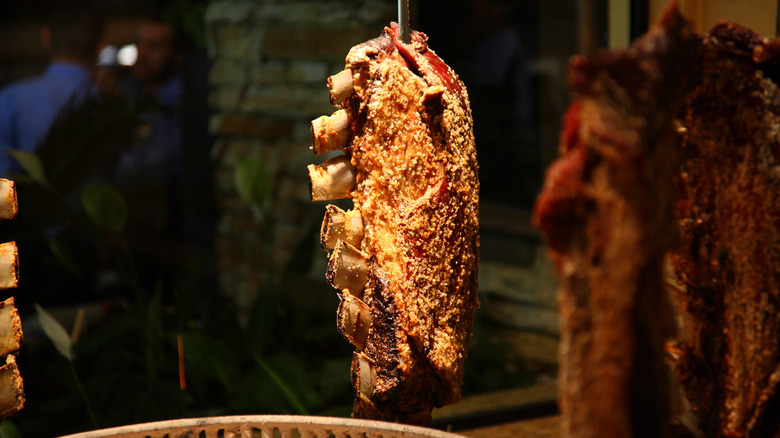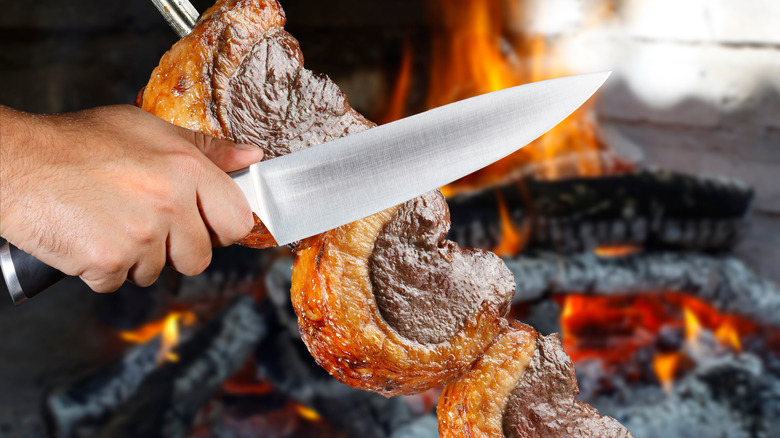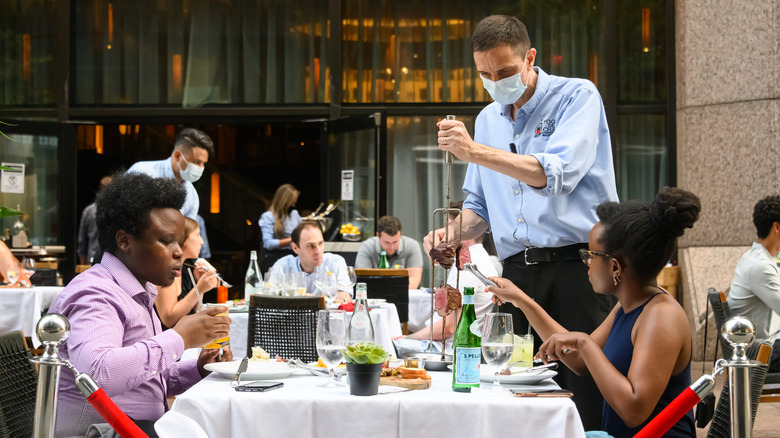What Makes Brazilian Steakhouses Worth The Hefty Price?
Dining at a Brazilian steakhouse is a one-of-a-kind experience. Whether you visit a chain like Fogo de Chão or an independent restaurant, you can likely expect a similar atmosphere and dining format. You can also expect a lot of meat.
Traditionally, Brazilian steakhouses serve food rodízio-style. This involves an all-you-can-eat experience with gaucho chefs (Brazilian cowboys) circling the room with skewers of meat and carving them table-side. A meat-lover's paradise, these steakhouses usually offer a variety of meats and cuts, including top sirloin, filet mignon, pork chop, lamb, and even wagyu.
As for the cost, you can expect a night out at a Brazilian steakhouse to come with a higher price tag. This is because at most steakhouses, you pay one price for an all-you-can-eat experience. Make that an all-you-can-eat experience featuring expensive cuts of meat, and it makes sense that Brazilian steakhouses are pricier than your average buffet. So what makes them worth the price? We'd say it's a combination of the quantity and quality of food you get. Plus, it is a unique, authentic experience enveloped in South American history.
What to expect when visiting a Brazilian steakhouse
Many steakhouses in Brazil claim to have invented the rodízio style of dining, making it difficult to discern the tradition's true origin. However, legend has it rodízio was invented at a restaurant called Churrascaria Matias in Rio Grande do Sul after a waiter served a skewer of meat to the wrong person and allowed that person to take a small portion. The barbecue concept gained popularity in Brazil in the 1970s, and in the '80s, it evolved into a fine dining experience, which eventually made its way to the United States.
Now, there are many Brazilian steakhouses throughout the United States, including 92 restaurants that are part of chains such as Fogo de Chão, Rodizio Grill, and Texas de Brazil. Because many of these chains and restaurants are modeled after Brazilian churrascarias (steakhouses that serve food rodízio-style), they offer a similar experience. An important tip? Arrive hungry.
Usually, guests pay one price for unlimited meat, as well as sides, soups, and salads that are either served table-side or at a walk-up salad bar. Typically, restaurants provide red and green cards for guests to indicate whether they want more food or they are taking a break. As for the pricing, the all-you-can-eat option varies by restaurant and location. However, it usually ranges between $45 and $65 per person. Restaurants often also offer individual entrees for those who choose not to opt in to the full rodízio-style experience.
The quality of Brazilian steakhouses
Brazilian steakhouses offer a fine dining experience, with many providing a "white tablecloth," upscale atmosphere. This also means that the restaurants often run as well-oiled machines. At Fogo de Chão, for example, each waiter is responsible for their meat of the night, from prepping, to cooking, to carving, to serving. Many of these waiters are from Brazil or have worked at other Brazilian steakhouses, and USA Today notes that their "service is impressive."
In addition to the quality of the atmosphere and service, Brazilian steakhouses offer high-quality food. Considering the all-you-can-eat format, it would be easy to lump Brazilian steakhouses in with other buffets; however, the foods offered are a level up from a traditional buffet. The main attraction is the meat, and steaks and other red meats dominate the menu, including expensive cuts like picanha and filet mignon. Usually, the meat is slow cooked on rotating rotisseries, a time-intensive process that leads to a tender, melt-in-your-mouth outcome. All in all, you can expect top-notch quality when visiting a Brazilian steakhouse.


